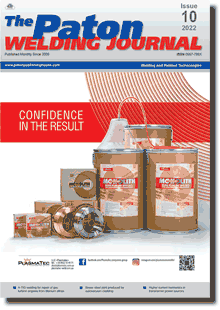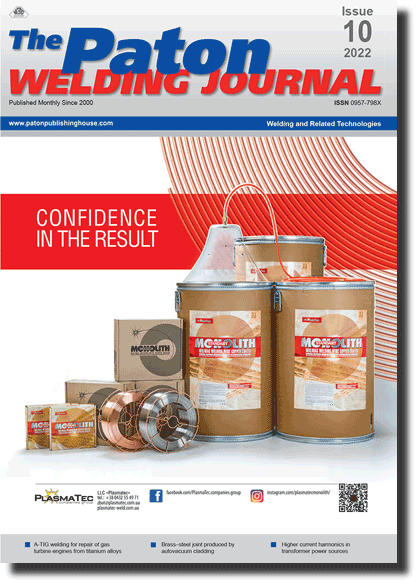| 2022 №10 (07) |
DOI of Article 10.37434/tpwj2022.10.08 |
2022 №10 (01) |

The Paton Welding Journal, 2022, #10, 49-56 pages
Plasmo-chemical process of obtaining nanosilicon for lithium-ion batteries
S.V. Petrov1, S.G. Bondarenko2, Sato Koichi3
1The Gas Institute of the National Academy of Sciences of Ukraine 39, Degtyarivska str., Kyiv, Ukraine, 03113. E-mail: svp_plazer@i.ua
2National Technical University of Ukraine «Igor Sikorsky Kyiv Polytechnic Institute». 37, Pobedy ave., Kyiv, Ukraine, 03056. E-mail: s_g_bondarenko@ukr.net
3Kankyo Techno Co. LTD Japan. 959-2633 Niigata pref. Tainai city Sekizawa 69-5. E-mail: bz659804@bz04.plala.or.jp
Abstract
The process of complete plasma evaporation of the initial solid material for the synthesis of Si — nanoparticles as applied to lithium-ion batteries and energy storage devices was studied in this work. The use of numerical modeling methods made it possible to determine the flow parameters of a two-phase high-temperature flow - temperature fields, velocities and concentrations. To study the processes of evaporation and subsequent synthesis of nanopowders, a plasma reactor with an electric arc plasmatron with a linear circuit and using an argon-hydrogen mixture as a plasma-forming gas was developed. The influence of the external magnetic field on control of the plasma jet parameters was studied in a series of experiments using an electric arc plasmatron in plasma laboratory installations of 30 and 150 kW power. The influence of the magnetic field on the configuration, geometric dimensions and structure of the initial section of the plasma jet was determined. The initial dispersed material — silicon powder was fed to the section of the plasmatron nozzle in a radial pattern. Experimental confirmation of the phenomenon of elongation of the high-temperature initial section of the plasma jet in an axial magnetic field was obtained. It was experimentally established that the creation of a peripheral gas curtain significantly improves the characteristics of heat and mass transfer in the reactor. The influence of two-phase flow, heat exchange and mass flow of nanoparticles, including on the surface of a plasma reactor with a limited jet flow, in the processes of obtaining silicon nanopowders was studied. The obtained regularities can be used to develop and put into operation a pilot plant for high-performance production of nanosilicon powders. Ref. 12, Fig. 10.
Keywords: plasma-chemical synthesis; arc reactor; plasma jet; nanosilicon; lithium-ion battery; numerical modeling
Received: 11.07.2022
Accepted: 01.12.2022
References
1. Berdichevsky, G. (2020) The future of energy storage towards a perfect battery with global scale. September 2, 2020. https://www.silanano.com/uploads/Sila-_-The%-Future-of-Energy-Storage-White-Paper.pdf2. Yuca, N., Taskin, O.S., Arici, E. (2020) An overview on efforts to enhance the Si electrode stability for lithium ion batteries. Energy Storage, 2(1). https://doi.org/10.1002/est2.94
3. Kuksenko, S.P., Tarasenko, Y.O., Kaleniuk, H.O., Kartel, M.T. (2020) Stable silicon electrodes with vinyliden fluoride polymer binder for lithium-ion batteries. Khimiya, Fizyka ta Tekhnologiya Poverhni, 11(1), 58-71 [in Ukrainian]. https://doi.org/10.15407/hftp11.01.058
4. Jaumann,T., Gerwig, M., Balach, J. et al. (2017) Dichlorosilane-derived nano-silicon inside hollow carbon spheres as a high-performance anode for Li-ion batteries. J. of Materials Chemistry A, 5, 9262-9271. https://doi.org/10.1039/C7TA00188F
5. Schwan, J., Nava, G., Mangolini, L. (2020) Critical barriers to the large scale commercialization of silicon-containing batteries. Nanoscale Adv., 2, 4368-4389. https://doi.org/10.1039/D0NA00589D
6. Petrov, S.V. (2021) Innovative plasma-spraying technologies. LAMBERT Academic Publ. [in Russian].
7. Zhang, X., Wang, Y., Min, B. et al. (2021) A controllable and byproduct-free synthesis method of carbon-coated silicon nanoparticles by induction thermal plasma for lithium ion battery. Advanced Powder Technology, 32(8), 2828-2838. https://doi.org/10.1016/j.apt.2021.06.003
8. Shigeta, M. (2018) Numerical study of axial magnetic effects on a turbulent thermal plasma jet for nanopowder production using 3D time-dependent simulation. J. of Flow Control, Measurement & Visualization, 6(2), 107-123. https://doi.org/10.4236/jfcmv.2018.62010
9. Petrov, S., Korzhyk, V. (2016) Plasma process of silicon production for photovoltaic power generation. Engineering and Technology, 3(5), 74-88.
10. Petrov, S.V. (2013) Plasmotron engineering. Stages of development. Svarshchik, 43(3), 26-31 [in Russian].
11. Astashov, A.G. (2016) Distribution of density of heat and mass flows in plasma reactor with limited jet flow in process of producing nanopowders. Moscow, IMET RAN [in Russian].
12. Tekna Plasma Systems Inc. http://tekna.com/
Suggested Citation
S.V. Petrov, S.G. Bondarenko, Sato Koichi (2022) Plasmo-chemical process of obtaining nanosilicon for lithium-ion batteries. The Paton Welding J., 10, 49-56.The cost of subscription/purchase order journals or individual articles
| Journal/Currency | Annual Set | 1 issue printed |
1 issue |
one article |
| TPWJ/USD | 384 $ | 32 $ | 26 $ | 13 $ |
| TPWJ/EUR | 348 € | 29 € | 24 € | 12 € |
| TPWJ/UAH | 7200 UAH | 600 UAH | 600 UAH | 280 UAH |
| AS/UAH | 1800 UAH | 300 UAH | 300 UAH | 150 UAH |
| AS/USD | 192 $ | 32 $ | 26 $ | 13 $ |
| AS/EUR | 180 € | 30 € | 25 € | 12 € |
| SEM/UAH | 1200 UAH | 300 UAH | 300 UAH | 150 UAH |
| SEM/USD | 128 $ | 32 $ | 26 $ | 13 $ |
| SEM/EUR | 120 € | 30 € | 25 € | 12 € |
| TDNK/UAH | 1200 UAH | 300 UAH | 300 UAH | 150 UAH |
| TDNK/USD | 128 $ | 32 $ | 26 $ | 13 $ |
| TDNK/EUR | 120 € | 30 € | 25 € | 15 € |
AS = «Automatic Welding» - 6 issues per year;
TPWJ = «PATON WELDING JOURNAL» - 12 issues per year;
SEM = «Electrometallurgy Today» - 4 issues per year;
TDNK = «Technical Diagnostics and Non-Destructive Testing» - 4 issues per year.


